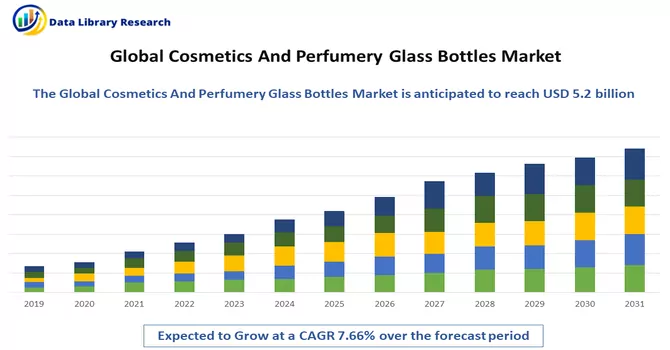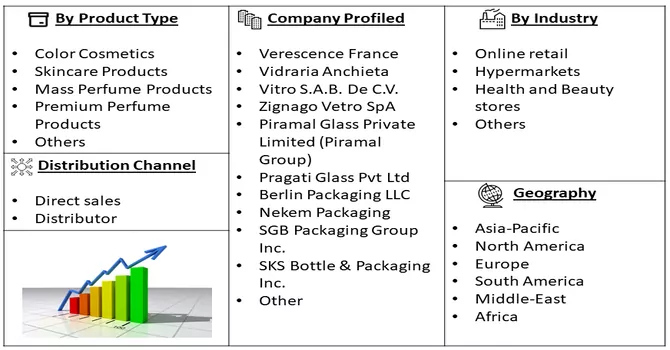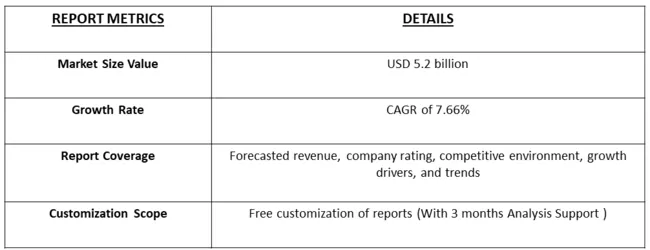The Cosmetics And Perfumery Glass Bottles Market size is estimated at USD 5.2 billion in 2023 and is expected to register a CAGR of 7.66% during the forecast period (2024-2031).

Get Complete Analysis Of The Report - Download Free Sample PDF
The cosmetics and perfumery glass bottles market serves as a critical component of the beauty and fragrance industry, providing packaging solutions that blend aesthetics with functionality. These glass bottles are instrumental in preserving the integrity of cosmetic and fragrance formulations, shielding them from external factors such as light and air to maintain product quality. The market witnesses constant innovation in bottle design, closures, and decorative elements to align with evolving consumer preferences and brand identities. With a focus on sustainability, there is a growing trend towards eco-friendly packaging, driving the adoption of recycled and recyclable glass materials.
As the beauty and fragrance sectors continue to flourish globally, the cosmetics and perfumery glass bottles market plays a pivotal role in shaping the visual appeal, protection, and sustainability of a diverse range of beauty and fragrance products. The driving force behind the growth of the cosmetics and perfumery glass bottles market lies in the convergence of consumer preferences for premium aesthetics and the industry's commitment to sustainability. Glass bottles are favoured in the cosmetics and perfume industry for their inherent premium appearance, providing a sophisticated and luxurious presentation for high-end beauty and fragrance products. The market is witnessing an increasing demand for unique and visually appealing packaging designs, with glass bottles offering versatility for creative and intricate shapes, as well as opportunities for innovative branding.Moreover, the sustainability trend is a significant growth factor, as consumers and manufacturers alike recognize the environmental advantages of glass packaging. Glass is fully recyclable, allowing for the creation of a closed-loop system and reducing the ecological impact of packaging waste. As eco-consciousness continues to influence consumer choices, the cosmetics and perfumery glass bottles market is propelled by the dual appeal of premium aesthetics and environmental responsibility, shaping the industry's approach to packaging solutions.
Market Segmentation: The Cosmetics and Perfumery Glass Bottles Market Report is Segmented by Type (Perfumes, Nail Care, Skin Care, and Other Product Types) and Geography (North America, Europe, Asia-Pacific, Latin America, and Middle East & Africa). The Market Sizes and Forecasts are Provided in Terms of Value (USD) for all the Abovementioned Segments.

For Detailed Market Segmentation - Download Free Sample PDF
Market trends in the cosmetics and perfumery glass bottles segment underscore a dynamic landscape driven by evolving consumer preferences and industry-wide initiatives. One prominent trend is the increasing emphasis on sustainable and eco-friendly packaging solutions. As environmental consciousness grows among consumers, there is a notable shift towards the adoption of recycled glass and recyclable materials in glass bottle production. Brands are actively aligning their packaging strategies with sustainability goals to meet the rising demand for environmentally responsible choices.Additionally, customization and personalization have become key trends in the market. Brands are leveraging the versatile nature of glass to offer unique bottle shapes, intricate designs, and customized decorative elements that resonate with their target audience. This trend caters to the desire for exclusive and personalized packaging experiences, enhancing brand loyalty and consumer engagement.Furthermore, the convergence of digital technology with packaging is influencing the cosmetics and perfumery glass bottles market. Augmented reality (AR) and interactive packaging solutions are being explored to create immersive and engaging consumer experiences. Brands are integrating technology to tell a story, provide product information, or offer virtual try-on experiences, enhancing the overall consumer journey. Overall, the cosmetics and perfumery glass bottles market is witnessing a transformation driven by sustainability, customization, and technological integration, reflecting the industry's response to dynamic consumer expectations and market demands.
Market Drivers:
The insatiable demand for premium aesthetics
The insatiable demand for premium aesthetics has become a defining factor across various consumer industries, particularly in the beauty and luxury segments. Consumers, driven by a desire for sophistication and exclusivity, increasingly seek products and packaging that exude a sense of opulence and refinement. In sectors like cosmetics and perfumery, this demand translates into a preference for high-end packaging materials, such as glass bottles. The inherent visual appeal and luxurious touch of glass contribute significantly to the perceived value of beauty products, creating an immersive and premium experience for consumers. As brands continue to vie for consumer attention and loyalty, the pursuit of premium aesthetics remains a potent driver, influencing product design, packaging choices, and overall brand positioning in the competitive market landscape.
Brand distinctiveness
Brand distinctiveness is a crucial element in today's competitive market, where consumers are inundated with choices. It refers to a brand's ability to stand out and be instantly recognizable, setting itself apart from competitors. In industries like cosmetics and perfumery, where visual appeal plays a pivotal role, achieving brand distinctiveness often involves strategic packaging choices. Unique packaging materials, innovative designs, and distinctive features, such as logos or embellishments, contribute to creating a strong visual identity for a brand. In the cosmetics and perfumery market, brand distinctiveness is not only about creating a memorable impression but also about conveying a brand's values and personality, fostering consumer loyalty, and influencing purchasing decisions. As brands strive for a lasting impact, the pursuit of brand distinctiveness becomes a powerful driver in shaping their marketing strategies and product presentations.
Market Restraints:
Market restraints for the cosmetics and perfumery glass bottles industry include challenges related to weight and fragility. While glass bottles offer a premium and eco-friendly packaging solution, their heavy weight can contribute to higher transportation costs, impacting overall logistics efficiency. Fragility is another concern, as glass bottles are susceptible to breakage during handling, shipping, or even in-store, leading to potential losses for manufacturers and retailers. Additionally, the production of glass involves substantial energy consumption, contributing to the carbon footprint. As sustainability becomes a focal point, addressing these challenges and finding innovative solutions to reduce weight, enhance durability, and minimize environmental impact will be crucial for the sustained growth of the cosmetics and perfumery glass bottles market.
The COVID-19 pandemic has presented a mixed impact on the cosmetics and perfumery glass bottles market. On one hand, the increased focus on personal hygiene and skin care during the pandemic has driven demand for beauty and fragrance products, positively influencing the market. However, disruptions in the global supply chain, factory closures, and logistical challenges have posed impediments to the production and distribution of glass bottles. The industry also witnessed shifts in consumer behaviour, with a growing preference for online purchases, impacting traditional retail channels. Additionally, the economic uncertainties during the pandemic have led to cautious spending patterns among consumers, affecting overall market dynamics. As the world navigates through the post-pandemic recovery phase, adaptability and strategic resilience will be essential for the cosmetics and perfumery glass bottles market to overcome ongoing challenges and capitalize on emerging opportunities.
Segmental Analysis:
Skin Care Segment is Expected to Witness Significant Growth Over the Forecast Period
The Skin Care Segment is a pivotal category within the broader Cosmetic and Perfumery Market, witnessing substantial growth driven by evolving consumer preferences and a heightened focus on personal grooming. This segment encompasses a wide array of products, including cleansers, moisturizers, and anti-ageing solutions, catering to diverse skincare needs. The Cosmetic and Perfumery Market, in tandem, reflects an increasing demand for a variety of beauty products, including fragrances and cosmetics. Changing lifestyle trends, a growing emphasis on wellness, and innovations in product formulations contribute to the robust expansion of these markets. As consumers seek high-quality and innovative skincare and beauty solutions, the Skin Care Segment plays a central role in shaping the overall dynamics of the thriving Cosmetic and Perfumery Market.
North America Region is Expected to Witness Significant Growth Over the Forecast Period
North America holds a prominent position in the Cosmetic and Perfumery Market, representing a robust and dynamic industry. The region is characterized by a discerning consumer base that places a high value on beauty and personal care. The Cosmetic and Perfumery Market in North America encompasses a wide range of products, including skincare, cosmetics, and fragrances, driven by evolving beauty trends and lifestyle preferences. With a focus on quality, innovation, and sustainability, North American consumers contribute to the market's continual growth. Additionally, the region serves as a hub for cosmetic industry innovation, with a multitude of product launches and trends originating from North American brands. The competitive landscape is shaped by established and emerging players, fostering a dynamic market that responds swiftly to changing consumer demands and preferences. As North America continues to lead in shaping beauty standards and trends, the Cosmetic and Perfumery Market remains a thriving and influential sector within the region.

Get Complete Analysis Of The Report - Download Free Sample PDF
The analyzed market exhibits a high degree of fragmentation, primarily attributable to the presence of numerous players operating on both a global and regional scale. The competitive landscape is characterized by a diverse array of companies, each contributing to the overall market dynamics. This fragmentation arises from the existence of specialized solution providers, established industry players, and emerging entrants, all vying for market share. The diversity in market participants is underscored by the adoption of various strategies aimed at expanding the company presence. On a global scale, companies within the studied market are strategically positioning themselves through aggressive expansion initiatives. This often involves entering new geographical regions, targeting untapped markets, and establishing a robust global footprint. The pursuit of global expansion is driven by the recognition of diverse market opportunities and the desire to capitalize on emerging trends and demands across different regions. Simultaneously, at the regional level, companies are tailoring their approaches to align with local market dynamics. Regional players are leveraging their understanding of specific market nuances, regulatory environments, and consumer preferences to gain a competitive edge. This regional focus allows companies to cater to the unique needs of local clientele, fostering stronger market penetration. To navigate the complexities of the fragmented market, companies are implementing a range of strategies. These strategies include investments in research and development to stay at the forefront of technological advancements, mergers and acquisitions to consolidate market share, strategic partnerships for synergies, and innovation to differentiate products and services. The adoption of such multifaceted strategies reflects the competitive nature of the market, with participants continually seeking avenues for growth and sustainability. In essence, the high fragmentation in the studied market not only signifies the diversity of players but also underscores the dynamism and competitiveness that drive ongoing strategic manoeuvres. As companies explore various avenues for expansion, the market continues to evolve, presenting both challenges and opportunities for industry stakeholders.
Some of the key market players are:
Recent Development:
1) In October 2023, Vitro Sab de CV marked a significant milestone with the inauguration of "Coater 8," a state-of-the-art glass coating oven at its Mexicali plant in Mexico. Representing a substantial investment of USD 60 million, Coater 8 enhances Vitro's production capacity by adding over 6 million sq.m. of coated glass to its portfolio. This cutting-edge facility leverages nanotechnology coatings to regulate solar radiation, meeting the surging demand for advanced thermal insulation in applications like architectural and automotive glass.
2) In March 2023, Verescence Luxury introduced Glass Score, a groundbreaking tool for the perfume and cosmetics industry. This innovative tool enables Verescence's customers to quantify weight reduction in their products, irrespective of container size. By facilitating the measurement of environmental impact from design to conception, Glass Score aligns with Verescence's commitment to minimizing the ecological footprint of glass bottles. These developments underscore the industry's continuous efforts to integrate advanced technologies and sustainable practices, positioning glass as a versatile and eco-friendly material in the competitive landscape.
Q1. What was the Market size in 2023?
As per Data Library Research the Cosmetics And Perfumery Glass Bottles Market size is estimated at USD 5.2 billion in 2023.
Q2. What is the Growth Rate of the Cosmetics and Perfumery Glass Bottles Market?
Cosmetics and Perfumery Glass Bottles Market is expected to register a CAGR of 7.66% during the forecast period.
Q3. What are the factors driving the Cosmetics and Perfumery Glass Bottles Market?
Key factors that are driving the growth include the insatiable demand for premium aesthetics and Brand distinctiveness
Q4. What Impact did COVID-19 have on the Cosmetics and Perfumery Glass Bottles Market?
The COVID-19 pandemic has presented a mixed impact on the cosmetics and perfumery glass bottles market. For Detailed Insight request a sample here.
Data Library Research are conducted by industry experts who offer insight on industry structure, market segmentations technology assessment and competitive landscape (CL), and penetration, as well as on emerging trends. Their analysis is based on primary interviews (~ 80%) and secondary research (~ 20%) as well as years of professional expertise in their respective industries. Adding to this, by analysing historical trends and current market positions, our analysts predict where the market will be headed for the next five years. Furthermore, the varying trends of segment & categories geographically presented are also studied and the estimated based on the primary & secondary research.
In this particular report from the supply side Data Library Research has conducted primary surveys (interviews) with the key level executives (VP, CEO’s, Marketing Director, Business Development Manager and SOFT) of the companies that active & prominent as well as the midsized organization
FIGURE 1: DLR RESEARH PROCESS

Extensive primary research was conducted to gain a deeper insight of the market and industry performance. The analysis is based on both primary and secondary research as well as years of professional expertise in the respective industries.
In addition to analysing current and historical trends, our analysts predict where the market is headed over the next five years.
It varies by segment for these categories geographically presented in the list of market tables. Speaking about this particular report we have conducted primary surveys (interviews) with the key level executives (VP, CEO’s, Marketing Director, Business Development Manager and many more) of the major players active in the market.
Secondary ResearchSecondary research was mainly used to collect and identify information useful for the extensive, technical, market-oriented, and Friend’s study of the Global Extra Neutral Alcohol. It was also used to obtain key information about major players, market classification and segmentation according to the industry trends, geographical markets, and developments related to the market and technology perspectives. For this study, analysts have gathered information from various credible sources, such as annual reports, sec filings, journals, white papers, SOFT presentations, and company web sites.
Market Size EstimationBoth, top-down and bottom-up approaches were used to estimate and validate the size of the Global market and to estimate the size of various other dependent submarkets in the overall Extra Neutral Alcohol. The key players in the market were identified through secondary research and their market contributions in the respective geographies were determined through primary and secondary research.
Forecast Model
